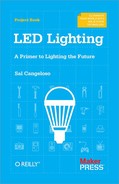Perhaps at this point you are thinking that LED bulbs are the way to go. Maybe even that you should go out and buy some. Great…but if you’re not buying new lighting fixtures at the same time, then you probably already have bulbs. What should you do with them?
The general rule of thumb when it comes to green living and prudent ownership is to finish using whatever you have before buying something new. For example, you might be excited to get rid of your old car and hop into a shiny new plug-in hybrid, but that car will have to be manufactured and shipped, and then something will have to happen with your old car. So while the new automobile will be more efficient than your previous one, the power and cost savings will still take a long time to accrue. Using this logic, there is no reason to rush the purchase unless you expect a drastic difference immediately (maybe you were driving around in an 18-wheeler?). This scenario also applies to lighting, as well as any other trade-off made for the sake of efficiency.
Theories aside, what if you just want to make your purchase now? If that’s the case, you don’t really need to think twice about your incandescents. They are quite cheap and they last for about 1,000 hours (about 11 months of life at 3 hours of usage a day), so if you can’t remember installing them and they are in a room you use often, then they probably don’t have much life left anyway.
CFLs are trickier because these bulbs aren’t as cheap, they last much longer than incandescents, disposing of them properly is a pain, and they don’t use much more power than a typical LED lamp. By way of example, I recently purchased a Philips AmbientLED bulb that I was going to put in my living room, in a fixture that I thought used an incandescent. I checked under the lampshade and saw that I was actually using a N:Vision CFL bulb. I tested the fixture at the socket, using a Kill A Watt meter, and found that it was running at 15W, a reasonable amount for a 60W equivalent bulb. I put in the Philips LED bulb and it consumed 12W of power. At a difference of 3W, I would have saved just $2.89 if I were to run the bulbs continuously for a year (assuming $0.11/kWh). At a more reasonable three hours a day, I would have saved myself about 36 cents over that same period.
Assuming a standard CFL costs about $2 today (they are generally sold in large packages, so they can be cheaper than this), it would take something like 5.5 years for me to get that $2 purchase back, assuming electricity prices don’t increase. If I wanted to consider the added cost of the LED bulb (about $26), then I’d be waiting a long time before the swap became cost effective. Even once I factor in the cost of the new CFL bulbs, I would need to buy to replace worn out ones during the life of the LED; case in point: it would take a number of years for the LED route to become cost effective.
Ultimately, it doesn’t really make sense to throw out your CFL bulbs. If you are happy with the light they provide and you don’t mind the startup delay (if they have one), then the main case for getting rid of them would be if they are in spots where you think they might break, like in a hard-to-reach ceiling fixture. Short of that they will do their job for years and barely cost you any more than an LED lamp.
